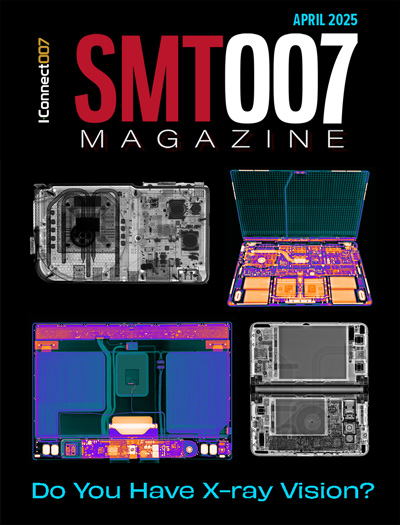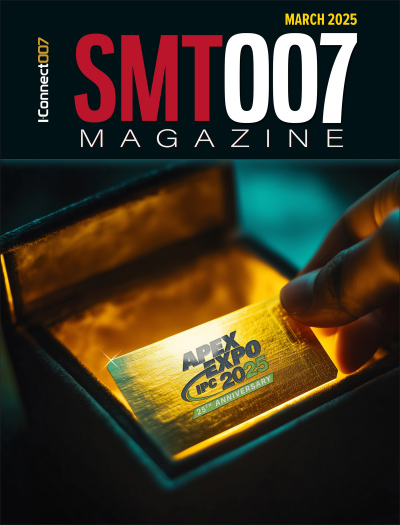-

- News
- Books
Featured Books
- smt007 Magazine
Latest Issues
Current Issue
Do You Have X-ray Vision?
Has X-ray’s time finally come in electronics manufacturing? Join us in this issue of SMT007 Magazine, where we answer this question and others to bring more efficiency to your bottom line.

IPC APEX EXPO 2025: A Preview
It’s that time again. If you’re going to Anaheim for IPC APEX EXPO 2025, we’ll see you there. In the meantime, consider this issue of SMT007 Magazine to be your golden ticket to planning the show.

Technical Resources
Key industry organizations–all with knowledge sharing as a part of their mission–share their technical repositories in this issue of SMT007 Magazine. Where can you find information critical to your work? Odds are, right here.
- Articles
- Columns
Search Console
- Links
- Media kit
||| MENU - smt007 Magazine
A Guide to Infrared (IR) Rework on BGAs
December 31, 1969 |Estimated reading time: 8 minutes
By Roger Gibbs, PDR
BGAs, now mainstream for manufacturers seeking better device functionality and quality, present some problems for rework-and-repair processes. Infrared soldering/desoldering technology is safer, more repeatable, and easier to operate than prior technologies for reworking BGAs.
Shrinking board real estate has helped accelerate the move to higher-I/O-count packages, particularly flip chip and ball grid array (BGA) technologies. Most major manufacturers are using BGAs, as the inherent advantages over traditional plastic leaded chip carriers (PLCCs) and quad flat packs (QFPs) can prove profitable. BGAs, in general, are easier to place (they are, to some degree, self-centering) and offer more functionality in smaller, tougher packages.
BGAs do, however, present problems, particularly when it comes to repair and rework. Standard SMT components, for example, can be touched up a bad solder joint is visible and individual leads are repairable. There are no such options with BGAs. Hidden solder joints and BGA packages that are temperature-sensitive are just two factors that can complicate BGA soldering/desoldering.
For assemblers, the most important key to successful and profitable implementation of BGA technology is the ability to rework defective BGA components quickly, safely, and economically. If BGA assemblies cannot be repaired quickly and cost-effectively, the technology will never gain universal acceptance from traditional SMT assemblers.
In theory, soldering and desoldering BGAs is the same step-by-step process that technicians follow with more standard SMT components. To make the soldering/desoldering process effective and repeatable, technicians need the right equipment coupled with a thorough knowledge of each step involved.
Use of infrared (IR) technology for BGA soldering/desoldering offers repeatability, safety, and ease of use that are essential for cost-effective repair and rework. The handheld IR soldering/desoldering tool can be used to make BGA rework easier to accomplish and as IR is non-contact heating safer for the PCB and all types of BGA components. Using IR is essentially the same process as for hot gas and/or soldering irons; however, IR is intrinsically safer and more economical.
Establish Ramp Time and Dwell Time Preheat PCBConventional wisdom has it that when removing and replacing a BGA component, a strict component profile must be established so that temperature control (ramp time and dwell time) can be maintained properly. In general, BGAs cannot be heated as quickly as traditional SMT components. When heating BGAs, operators must heat through the component's body to reflow the connections, and this process must be gradual, 23°C/sec recommended. If dwell time is not sufficient, not all of the solder balls will be properly heated and the solder will not fully reflow.
With handheld non-contact IR heating, ramp times are controlled by adjusting the heat output and the distance between the handheld unit and target component. Some systems can add thermal profile storage capabilities and computer control for precise, repeatable temperature control.
After many failures and trial and error, the industry has realized that the first step to proper BGA rework is to preheat the PCB. Without a preheating stage, the board is prone to warp. Efficiently removing the BGA component must involve some type of preheating. Any unit, IR or hot gas, must have a back heater and/or preheating stage.
Component RemovalThere are a number of hot gas rework systems for BGA removal. The key to these units is temperature control, so the solder will reflow without damaging the substrate and the surrounding components. What makes gas rework problematical and expensive is selecting the proper nozzle for each BGA device. Some nozzles flow air above and below the PCB; others move air horizontally; some place air only on the top of the component. Depending on BGA type, sensitivity of the surrounding components, and their proximity, nozzle choice is critical and expensive. Various nozzles must be purchased and kept in stock for use with particular assemblies and components.
With handheld IR rework, the heat is focused, so there are no nozzles to select and buy. Eliminating nozzles and tips reduces cost, speeds the overall rework process, and removes a variable that can complicate the soldering/desoldering process.Finally, BGA removal is slower than the removal of SMT components. Time to remove a BGA component can average 810 minutes per device.
Cleaning the Area Removing Residual SolderCleaning the reworked area prior to replacing the BGA is a sometimes overlooked yet critical step. If residual solder is not removed, the new BGA component will not reflow properly, and the chance of substrate and soldermask damage is increased greatly.Traditional soldering/desoldering irons and hot gas units require highly skilled technicians. A soldering iron can ruin an entire assembly if it touches the component or substrate damaging lands and pads instantly.
Because the IR unit does not touch the PCB, there is no danger of pad-adjacent component damage. Technicians simply focus the unit on the area and, using a solder braid to remove the residual solder, heat the area then carefully drag the braid to pick up solder. With a soldering iron, it is critical to keep the braid between the iron's tip and the board. As there is no direct contact with the board using handheld IR tools, there is little or no chance of damaging the board or the device.
Once the residual solder is removed, the area should be cleaned with the proper solvent.
Placing the New BGAWhen removing a faulty BGA, component handling and heating are not critical. After all, the component is already damaged/defective. When replacing the component, however, greater temperature control is essential to maintain rework yields. Using PDR's hand held IR soldering/desoldering unit, temperature can be gradually applied and quickly adjusted. Again, ramp and dwell times are critical. While it is generally true that ceramic BGAs can take more thermal energy than plastic BGAs, the 2°C/sec. rule of thumb is good to follow regardless of BGA type. As with initial removal of the component, preheating is necessary to avoid board warpage.
Because BGAs are self-centering, replacing the component can be performed manually by a skilled technician without special optics. Many companies prefer to use a split optics vision system, with vacuum pickup to help align and place the component.
Cost of OwnershipBecause IR technology is easy to control, and offers an infinite range of temperature without the need for nozzles, tips, and the like, soldering/desoldering of BGAs has been made simpler. The more traditional hot gas systems and the now outdated soldering iron were technologies that had to be adapted for use with BGAs. Both methods are built upon the theory that a certain amount of scrap is inevitable: companies simply must balance yields with the cost of repair.
This philosophy, while economically feasible for lower-cost assemblies, does not hold water in an industry that has seen profit margins become razor thin and time to market shrink from months to weeks to literally days.
Soldering/desoldering with IR saves money by eliminating the need for tips and nozzles. In a large contract manufacturing facility or OEM, this "simple" concept can result in savings of hundreds of thousands of pounds.
IR's passive heating greatly reduces the risk of damage to boards and components, thus increasing the percentage of assemblies that can be properly repaired. In turn, overall yields increase while the total cost per assembly decreases.
Finally, as IR heat is inherently safer, technicians can spend less time worrying about board or component damage, and more time finishing the repair. As time is money, the less time spent per repair, the lower the cost and the faster the turnaround.
Understanding IR TechnologyFor most first-time users interested in IR technology for soldering/desoldering of SMT and BGA components, there is often a reluctance to embrace infrared because many do not understand the technology, nor do they immediately see its benefits.
As a basic introduction, IR technology treats a component and the PCB to very similar thermal conditions as in an in-line IR reflow oven and, as such, produces high-quality solder joints without problems associated with oxidation or stray solder ball migration. In practice, any component that can safely pass through an IR oven can be reworked using infrared.

In general, the IR rework method is non-contact, tool-free and uses IR from above and below as its source of heating. Medium-wave IR is used underneath to preheat the PCB and reduce the amount of energy and time required for top heating. Short-wave IR energy, derived from a UV-free 150W tungsten halogen spot lamp identical to those used in photographic and display lighting, is collimated and managed through a lens system that allows heating-area control and produces the red color for operator guidance (Figure 2). The method is passive and gentle; in fact, at full power the heating effect is so slight that you can hold your hand in the beam for considerable time before any effect is felt. Consequently, fragile devices, such as sockets/connectors, plastic BGAs, and sensitive high-speed components, can be carefully reworked with IR.
Conclusion Efficient, cost-effective BGA rework is essential if the component technology is to continue gaining mainstream acceptance. While reworking BGAs is not a new process, and it follows the basic steps of SMT soldering/desoldering, technicians must make adjustments to protect adjacents and the board itself.
Consistent, effective repair and rework can be achieved with proper technician training, proper use of rework equipment and supplies, and an understanding of the critical steps in BGA rework.
The overall soldering/desoldering process need not be complex. Adopting IR technology, BGA soldering/desoldering can be easily accomplished with relatively inexpensive hand-held tools.
IR's advantages are numerous: ramp and dwell times are easily controlled; the passive nature of IR heat make it much less likely to damage components or substrates. Nozzles, tips, shrouds, etc. an expensive part of hot gas systems are eliminated. IR technology is non-contact heating, so soldering tips or hot gas nozzles never touch the component or the PCB.
Finally, using IR technology simplifies the soldering/desoldering process. And while we've discussed five steps, the IR rework process is really as simple as apply flux, apply IR heat, and remove component.
Conventional wisdom has it that hot gas units are the only way to solder/desolder BGAs, but it wasn't long ago that this same conventional wisdom held that BGAs would never be mainstream. In both cases, the outmoded ways of thinking are wrong for today's high-speed, tight-margin electronics world.
Roger Gibbs may be contacted at PDR, Unit 3 The Stanley Centre, Kelvin Way, Crawley, West Sussex, England RH10 9SE; +44 (0)1293 846000; sales@pdr.co.uk.


